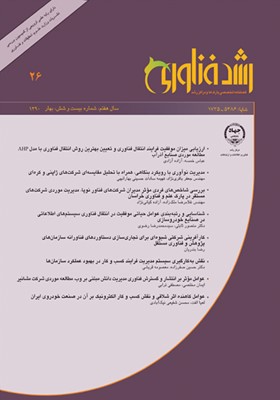مديريت نوآوري با رويکرد بنگاهي؛ همراه با تحليل مقايسهاي شرکتهاي ژاپني و کرهاي
محورهای موضوعی : نوآوري و خلاقيتجعفر باقری نژاد 1 , فهیمه سادات حسینی بهارانچی 2 *
1 - -
2 - -
کلید واژه: نوآوري, فرايند نوآوري, مديريت نوآوري, سازمان مبتكر و نوآور ,
چکیده مقاله :
نوآوري توانايي شناسايي فرصتها، مشاهدة روابط و استفاده از مزاياي آنهاست كه اين فرصت ها نه تنها در خصوص گشودن بازارهاي جديد، بلكه شامل روش هايي نوآورانه براي بازارهاي موجود نيز شامل هست. نوآوري ذاتاً امري پرمخاطره و داراي ريسك است و حتي شركتهاي رشد يافته و قوي نيز نمي توانند ريسك هاي نامحدود انجام دهند. در واقع سوال اين نيست كه آيا بايد نوآوري صورت گيرد يا نه، بلكه چگونه اين نوآوري به شكل موفقيت-آميزي انجام شود و چه درس هايي از موفقيت يا شكست آن می توان دریافت و اینکه آيا الگويي را مي توان براي آن به وجود آورد كه در فعاليت هاي آتي مورد بهره برداری قرار گیرد ؟ ازطرفی همواره اين پرسش بزرگ مطرح بوده است كه آيا مي توان آنچه را كه به عنوان نوآوري شناخته شده است، كنترل و مديريت كرد يا خير؟ در نگاه اول ممكن است مديريت نوآوري، فرايندي بسيار پيچيده و غيرممكن به نظر برسد؛ اما ما برين باوريم كه عليرغم ماهيت غيرقابل پيش بيني و تصادفي نوآوري، امكان يافتن يك الگوي اساسي موفقيت وجود دارد. چرا كه نوآوري، خود يك مسئله مديريتي است؛ از آن لحاظ كه بايد در خصوص منابع، جابجايي، تركيب و هماهنگي ميان آن ها تصميماتي اتخاذ گردد. در اين مقاله پس از شرح مطالبي پيرامون مفاهيم نوآوري و مديريت آن، يك مدل مفهومي و چگونگي استفاده از آن براي تمركز بر جنبه هاي كليدي مديريت نوآوري تشریح شده است. در ادامه، خلق و حفظ يك بافت سازماني خلاق مورد بحث قرار گرفته و در نهايت به تحليل مقايسه اي پيرامون مديريت نوآوري در شركتهاي ژاپني و كره اي پرداخته مي شود.
Innovation is the capability of identifying opportunities and using their advantages. These opportunities are not just opening new markets but include the innovative processes and ways for existing markets. Actually, innovation is not just production of goods, and examples of innovation can be seen in the service sector and public and private sectors. Innovation intrinsically is a risky project and even developed firms cannot accept infinite risks. In fact, the question is not that if innovation should be done or not, but rather how this innovation can be successful and which feedback could be gained from its success and failure and reaching a pattern that can be applied in future activities. Always the main question has been "whether or not we can control and manage what is known as innovation". At first glance, it might seem that managing innovation is impossible and a complex process. But we believe that despite the uncertain and apparently random-nature of the innovation, it is possible to find an underlying pattern of success. Innovation is a "management" issue because there are decisions to be made about resources, disposition, composition and coordination among them. In this paper after expressing concepts of innovation and managing innovation, a conceptual model and its usage structure is presented in order to concentrate on key aspects of managing innovation. Next, creation and maintenance of an innovative organizational context will be discussed and finally a comparative analysis of managing innovation between Japanese and Korean firms will be reflected.

